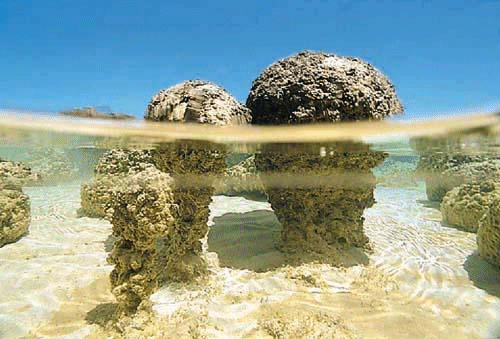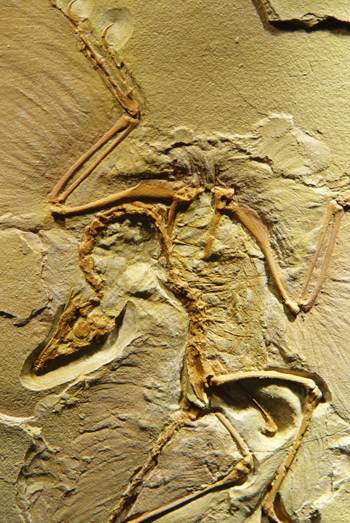The names and some history
 Precambrian (~4600 Ma – 542 Ma) – a ‘supereon’ composed of the Hadean, Archean and Proterozoic Eons.
Precambrian (~4600 Ma – 542 Ma) – a ‘supereon’ composed of the Hadean, Archean and Proterozoic Eons.
Hadean (~4600 Ma – 4000 Ma) – Stems from the word ‘Hades’ that means underworld. It refers to the initial conditions of Earth.
Archean (4000 Ma – 2500Ma) – Stems from the Greek word arkhē for beginning or origin
Proterozoic (2500 Ma – 542 Ma) – Stems from the Greek proto meaning ‘first’ and ‘zoon’ meaning ‘life’.
Phanerozoic (542 Ma – Present) – Stems from the Greek meaning ‘visible life’ or ‘revealed life’. Encompasses the Paleozoic, Mesozoic, and Cenozoic.
Paleozoic (542 Ma – 251 Ma) – from ‘paleo’ meaning old and ‘zoon’ meaning life. Encompasses the Cambrian, Ordovician, Silurian, Devonian, Carboniferous, Permian Periods.
Cambrian (542 Ma – 488.3 Ma) – Roman term for Wales, named by Adam Sedgwick (English), the lower Cambrian has been called the Waucoban in North America.
Ordovician (488.3 Ma – 443.7 Ma) – for a Welsh tribe that rebelled against Roman rule – coined by John Lapworth (English) – The Ordovician name stems from the controversy between Sedgwick and Murchison.
Silurian (443.7 Ma – 416 Ma) – From an ancient Celtic tribe of south Wales, named by Roderick Murchison (English)
Devonian (416 Ma – 359.2 Ma) – collaboration between Sedgwick and Murchison – imaginatively named for Devonshire.
Carboniferous (359.2 Ma – 299 Ma) [Mississippian (359.2 Ma – 318.1 Ma) / Pennsylvanian (318.1 Ma – 299 Ma)] – The term carboniferous is an adaptation of the British geologists’ term for the Coal Measures. In Europe, the term Carboniferous refers one continuous sequence. Found in North America, though, are two distinct entities, the Mississippian that includes an important phase of orogeny in the Appalachians, and the Pennsylvanian. The International Commission on Stratigraphy resolved the differences by subdividing the Carboniferous Period into periods named Mississippian and Pennsylvanian.
Permian (299 Ma – 251 Ma) – Murchison took this name from Perm, Russia.
Mesozoic (251 Ma – 65 Ma) – The name stems for the Greek words ‘meso’ meaning middle and ‘zoon’ meaning animal. The Mesozoic encompasses Triassic, Jurassic and Cretaceous Periods.
 Triassic (251 Ma – 199.6 Ma) – The German geologist Von Alberti named the Triassic after three rock layers found in Germany: red beds, chalk, and black shales. These rock layers represented the trias, hence, Triassic.
Triassic (251 Ma – 199.6 Ma) – The German geologist Von Alberti named the Triassic after three rock layers found in Germany: red beds, chalk, and black shales. These rock layers represented the trias, hence, Triassic.
Jurassic (199.6 Ma – 145.5 Ma) – The Jura Mountains in France contain an extensive amount of limestone formed during the time designated with their name. The term ‘Jurassic’ was first used by the French geologist Brogniart.
Cretaceous (145.5 Ma – 65.5 Ma) – Named by the Belgian geologist d’Hallow after ‘creta’ that is Latin for chalk, a significant part of the indicative strata.
Cenozoic (65.5 Ma – Present) – ‘new life’
Tertiary – The term ‘Tertiary’ is purely historic. Paleogene (65.5 Ma – 23 Ma) and Neogene (23 Ma – 2.59 Ma or 1.81 Ma, see below) officially replace Tertiary in the column.
Quaternary – According to the ICS, the base of the Quaternary and therefore the base of the Pleistocene is under review. The Quaternary starts either 2.59 Ma or the currently accepted 1.81 Ma. Pleistocene and Holocene combine to form the Quaternary.
Pleistocene (2.5 Ma or 1.81 Ma – 0.0117 Ma) – ‘pleistos’ – most, ‘kainos’ – new
Holocene (0.0117 Ma – Present) – ‘holo’ – entirely, ‘kainos’ – new. We are currently in the Holocene.
Suggestions have been made to add a new anthropocentric term to the end of the time scale: the Anthropocene.

